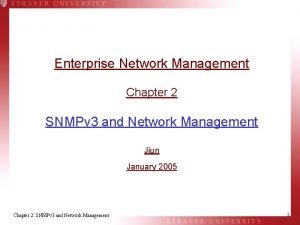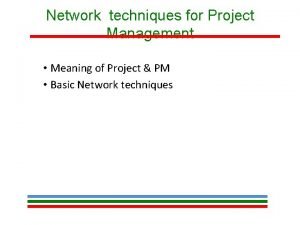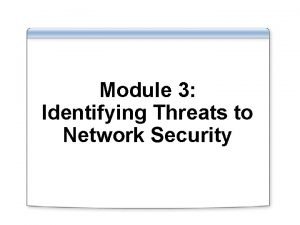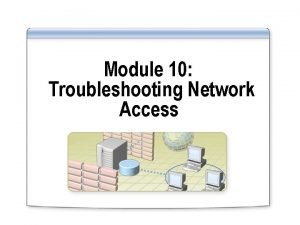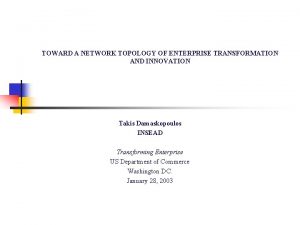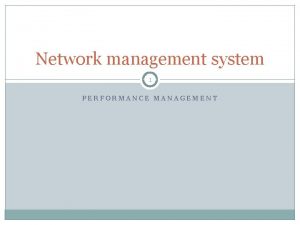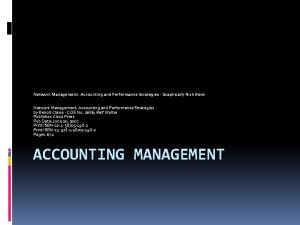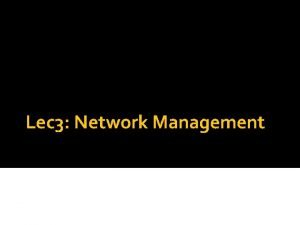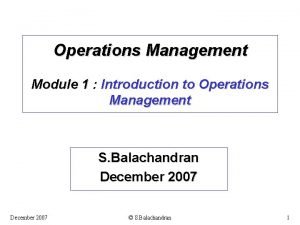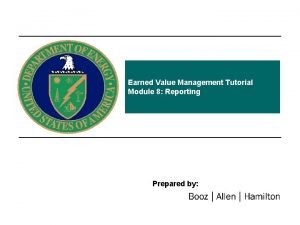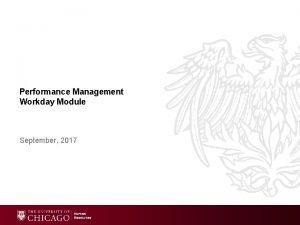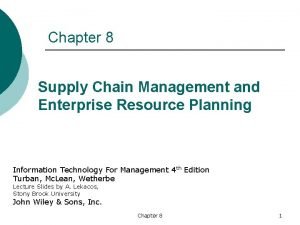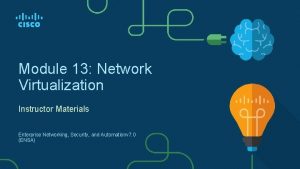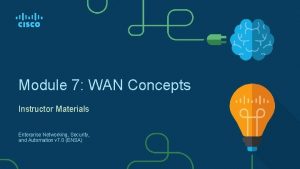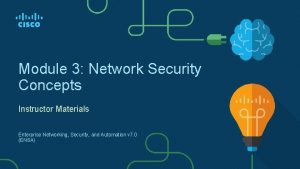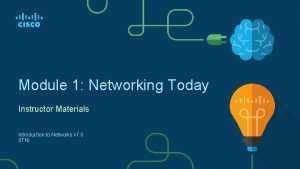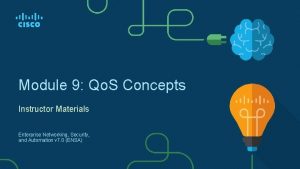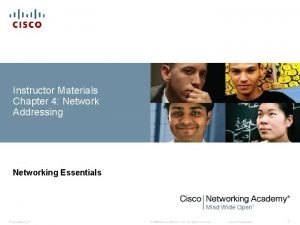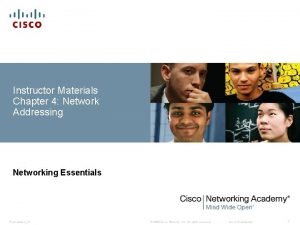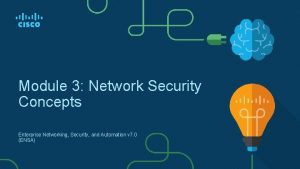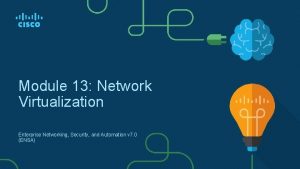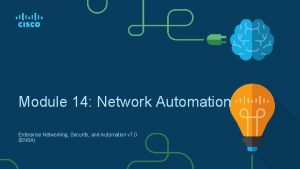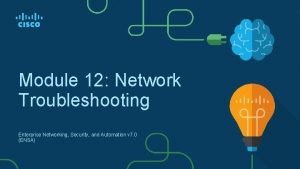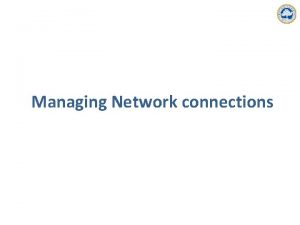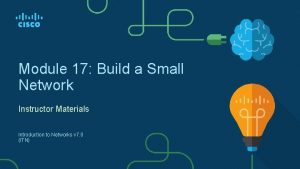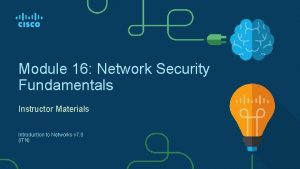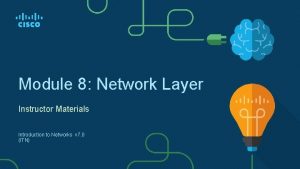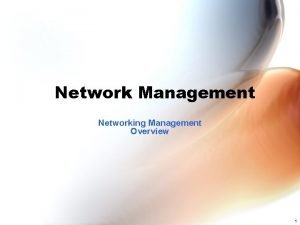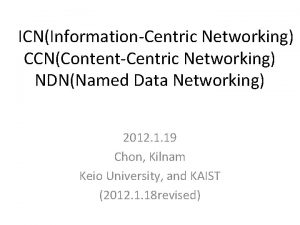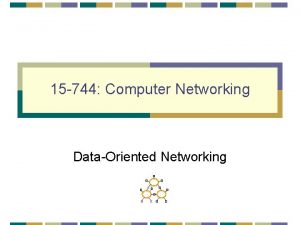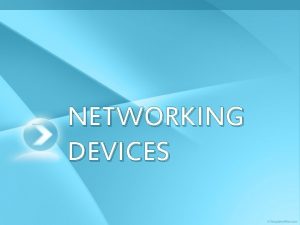Module 10 Network Management Instructor Materials Enterprise Networking

















































































- Slides: 81

Module 10: Network Management Instructor Materials Enterprise Networking, Security, and Automationv 7. 0 (ENSA)

Module 10: Network Management Enterprise Networking, Security, and Automation v 7. 0 (ENSA)

Module Objectives Module Title: Network Management Module Objective: Implement protocols to manage the network. Topic Title Topic Objective Device Discovery with CDP Use CDP to map a network topology. Device Discovery with LLDP Use LLDP to map a network topology. NTP Implement NTP between an NTP client and NTP server. SNMP Explain how SNMP operates. Syslog Explain syslog operation. Router and Switch File Maintenance Use commands to back up and restore an IOS configuration file. IOS Image Management Implement protocols to manage the network. © 2016 Cisco and/or its affiliates. All rights reserved. Cisco Confidential 12

10. 1 Device Discovery with CDP © 2016 Cisco and/or its affiliates. All rights reserved. Cisco Confidential 13

Device Discovery with CDP Overview CDP is a Cisco proprietary Layer 2 protocol that is used to gather information about Cisco devices which share the same data link. CDP is media and protocol independent and runs on all Cisco devices, such as routers, switches, and access servers. The device sends periodic CDP advertisements to connected devices. These advertisements share information about the type of device that is discovered, the name of the devices, and the number and type of the interfaces. © 2016 Cisco and/or its affiliates. All rights reserved. Cisco Confidential 14

Device Discovery with CDP Configure and Verify CDP • • For Cisco devices, CDP is enabled by default. To verify the status of CDP and display information about CDP, enter the show cdp command. To disable CDP on a specific interface, enter no cdp enable in the interface configuration mode. CDP is still enabled on the device; however, no more CDP advertisements will be sent out that interface. To enable CDP on the specific interface again, enter cdp enable. To enable CDP globally for all the supported interfaces on the device, enter cdp run in the global configuration mode. CDP can be disabled for all the interfaces on the device with the no cdp run command in the global configuration mode. Use the show cdp interface command to display the interfaces that are CDP-enabled on a device. The status of each interface is also displayed. © 2016 Cisco and/or its affiliates. All rights reserved. Cisco Confidential 15

Device Discovery with CDP Discover Devices by Using CDP • • With CDP enabled on the network, the show cdp neighbors command can be used to determine the network layout, as shown in the output. The output shows that there is another Cisco device, S 1, connected to the G 0/0/1 interface on R 1. Furthermore, S 1 is connected through its F 0/5 R 1# show cdp neighbors Capability Codes: R - Router, T - Trans Bridge, B - Source Route Bridge S - Switch, H - Host, I - IGMP, r - Repeater, P - Phone, D - Remote, C - CVTA, M - Two-port Mac Relay Device ID S 1 Local Intrfce Gig 0/0/1 Holdtme Capability 179 S I Platform WS-C 3560 - Port ID Fas 0/5 © 2016 Cisco and/or its affiliates. All rights reserved. Cisco Confidential 16

Device Discovery with CDP Discover Devices by Using CDP (Cont. ) The network administrator uses show cdp neighbors detail to discover the IP address for S 1. As displayed in the output, the address for S 1 is 192. 168. 1. 2. R 1# show cdp neighbors detail ------------Device ID: S 1 Entry address(es): IP address: 192. 168. 1. 2 Platform: cisco WS-C 3560 -24 TS, Capabilities: Switch IGMP Interface: Gigabit. Ethernet 0/0/1, Port ID (outgoing port): Fast. Ethernet 0/5 Holdtime : 136 sec (output omitted) © 2016 Cisco and/or its affiliates. All rights reserved. Cisco Confidential 17

Device Discovery with CDP Packet Tracer - Use CDP to Map a Network A senior network administrator requires you to map the Remote Branch Office network and discover the name of a recently installed switch that still needs an IPv 4 address to be configured. Your task is to create a map of the branch office network. To map the network, you will use SSH for remote access and the Cisco Discovery Protocol (CDP) to discover information about neighboring network devices, like routers and switches. © 2016 Cisco and/or its affiliates. All rights reserved. Cisco Confidential 18

10. 2 Device Discovery with LLDP © 2016 Cisco and/or its affiliates. All rights reserved. Cisco Confidential 19

Device Discovery with LLDP Overview Link Layer Discovery Protocol (LLDP) is a vendor-neutral neighbor discovery protocol similar to CDP. LLDP works with network devices, such as routers, switches, and wireless LAN access points. This protocol advertises its identity and capabilities to other devices and receives the information from a physically-connected Layer 2 device. © 2016 Cisco and/or its affiliates. All rights reserved. Cisco Confidential 20

Device Discovery with LLDP Configure and Verify LLDP • • • LLDP may be enabled by default. To enable LLDP globally on a Cisco network device, enter the lldp run command in the global config mode. To disable LLDP, enter the no lldp run command in the global config mode. LLDP can be configured on specific interfaces. However, LLDP must be configured separately to transmit and receive LLDP packets. To verify LLDP is enabled, enter the show lldp command in privileged EXEC mode. Switch# conf t Enter configuration commands, one per line. End with CNTL/Z. Switch(config)# lldp run Switch(config)# interface gigabitethernet 0/1 Switch(config-if)# lldp transmit Switch(config-if)# lldp receive Switch(config-if)# end Switch# show lldp Global LLDP Information: Status: ACTIVE LLDP advertisements are sent every 30 seconds LLDP hold time advertised is 120 seconds LLDP interface reinitialisation delay is 2 seconds © 2016 Cisco and/or its affiliates. All rights reserved. Cisco Confidential 21

Device Discovery with LLDP Discover Devices by Using LLDP With LLDP enabled, device neighbors can be discovered by using the show lldp neighbors command. S 1# show lldp neighbors Capability codes: (R) Router, (B) Bridge, (T) Telephone, (C) DOCSIS Cable Device (W) WLAN Access Point, (P) Repeater, (S) Station, (O) Other Device ID Local Intf Hold-time Capability Port ID R 1 Fa 0/5 117 R Gi 0/0/1 S 2 Fa 0/1 112 B Fa 0/1 Total entries displayed: 2 © 2016 Cisco and/or its affiliates. All rights reserved. Cisco Confidential 22

Device Discovery with LLDP Discover Devices by Using LLDP (Cont. ) When more details about the neighbors are needed, the show lldp neighbors detail command can provide information, such as the neighbor IOS version, IP address, and device capability. S 1# show lldp neighbors detail ------------------------Chassis id: 848 a. 8 d 44. 49 b 0 Port id: Gi 0/0/1 Port Description: Gigabit. Ethernet 0/0/1 System Name: R 1 System Description: Cisco IOS Software [Fuji], ISR Software (X 86_64_LINUX_. . . , RELEASE SOFTWARE (fc 2) Technical Support: http: //www. cisco. com/techsupport Copyright (c) 1986 -2019 by Cisco Systems, Inc. Compiled Thu 22 -Aug-19 18: 09 by mcpre Time remaining: 111 seconds System Capabilities: B, R Enabled Capabilities: R Management Addresses - not advertised (output omitted) © 2016 Cisco and/or its affiliates. All rights reserved. Cisco Confidential 23

Device Discovery with LLDP Packet Tracer - Use LLDP to Map a Network In this Packet Tracer activity, you will complete the following objectives: • Build the Network and Configure Basic Device Settings • Network Discovery with CDP • Network Discovery with LLDP © 2016 Cisco and/or its affiliates. All rights reserved. Cisco Confidential 24

10. 3 NTP © 2016 Cisco and/or its affiliates. All rights reserved. Cisco Confidential 25

NTP Time and Calendar Services • • The software clock on a router or switch starts when the system boots. It is the primary source of time for the system. It is important to synchronize the time across all devices on the network. When the time is not synchronized between devices, it will be impossible to determine the order of the events and the cause of an event. Typically, the date and time settings on a router or switch can be set by using one of two methods You can manually configure the date and time, as shown in the example, or configure the Network Time Protocol (NTP). R 1# clock set 20: 36: 00 nov 15 2019 R 1# *Nov 15 20: 36: 00. 000: %SYS-6 -CLOCKUPDATE: System clock has been updated from 21: 32: 31 UTC Fri Nov 15 2019 to 20: 36: 00 UTC Fri Nov 15 2019, configured from console by console. © 2016 Cisco and/or its affiliates. All rights reserved. Cisco Confidential 26

NTP Time and Calendar Services (Cont. ) As a network grows, it becomes difficult to ensure that all infrastructure devices are operating with synchronized time using the manual method. A better solution is to configure the NTP on the network. This protocol allows routers on the network to synchronize their time settings with an NTP server, which provides more consistent time settings. NTP can be set up to synchronize to a private master clock, or it can synchronize to a publicly available NTP server on the internet. NTP uses UDP port 123 and is documented in RFC 1305. © 2016 Cisco and/or its affiliates. All rights reserved. Cisco Confidential 27

NTP Operation NTP networks use a hierarchical system of time sources. Each level in this hierarchical system is called a stratum. The stratum level is defined as the number of hop counts from the authoritative source. The synchronized time is distributed across the network by using NTP. The max hop count is 15. Stratum 16, the lowest stratum level, indicates that a device is unsynchronized. © 2016 Cisco and/or its affiliates. All rights reserved. Cisco Confidential 28

NTP Operation (Cont. ) • • • Stratum 0: These authoritative time sources are high-precision timekeeping devices assumed to be accurate and with little or no delay associated with them. Stratum 1: Devices that are directly connected to the authoritative time sources. They act as the primary network time standard. Stratum 2 and Lower: Stratum 2 servers are connected to stratum 1 devices through network connections. Stratum 2 devices, such as NTP clients, synchronize their time by using the NTP packets from stratum 1 servers. They could also act as servers for stratum 3 devices. Time servers on the same stratum level can be configured to act as a peer with other time servers on the same stratum level for backup or verification of time. © 2016 Cisco and/or its affiliates. All rights reserved. Cisco Confidential 29

NTP Configure and Verify NTP • • Before NTP is configured on the network, the show clock command displays the current time on the software clock. With the detail option, notice that the time source is user configuration. That means the time was manually configured with the clock command. The ntp server ip-address command is issued in global configuration mode to configure 209. 165. 200. 225 as the NTP server for R 1. To verify the time source is set to NTP, use the show clock detail command. Notice that now the time source is NTP. R 1# show clock detail 20: 55: 10. 207 UTC Fri Nov 15 2019 Time source is user configuration R 1# config t R 1(config)# ntp server 209. 165. 200. 225 R 1(config)# end R 1# show clock detail 21: 01: 34. 563 UTC Fri Nov 15 2019 Time source is NTP © 2016 Cisco and/or its affiliates. All rights reserved. Cisco Confidential 30

NTP Configure and Verify NTP (Cont. ) The show ntp associations and show ntp status commands are used to verify that R 1 is synchronized with the NTP server at 209. 165. 200. 225. Notice that R 1 is synchronized with a stratum 1 NTP server at 209. 165. 200. 225, which is synchronized with a GPS clock. The show ntp status command displays that R 1 is now a stratum 2 device that is synchronized with the NTP server at 209. 165. 220. 225. R 1# show ntp associations address ref clock st when poll each delay offset disp *~209. 165. 200. 225. GPS. 1 61 64 377 0. 481 7. 480 4. 261 • sys. peer, # selected, + candidate, - outlyer, x falseticker, ~ configured R 1# show ntp status Clock is synchronized, stratum 2, reference is 209. 165. 200. 225 nominal freq is 250. 0000 Hz, actual freq is 249. 9995 Hz, precision is 2**19 (output omitted) © 2016 Cisco and/or its affiliates. All rights reserved. Cisco Confidential 31

NTP Configure and Verify NTP (Cont. ) • • The clock on S 1 is configured to synchronize to R 1 with the ntp server command the configuration is verified with the show ntp associations command. Output from the show ntp associations command verifies that the clock on S 1 is now synchronized with R 1 at 192. 168. 1. 1 via NTP. R 1 is a stratum 2 device, making S 1 is a stratum 3 device that can provide NTP service to other devices in the network. S 1(config)# ntp server 192. 168. 1. 1 S 1(config)# end S 1# show ntp associations address ref clock st when poll reach delay offset disp *~192. 168. 1. 1 209. 165. 200. 225 2 12 64 377 1. 066 13. 616 3. 840 • sys. peer, # selected, + candidate, - outlyer, x falseticker, ~ configured (output omitted) S 1# show ntp status Clock is synchronized, stratum 3, reference is 192. 168. 1. 1 nominal freq is 119. 2092 Hz, actual freq is 119. 2088 Hz, precision is 2**17 (output omitted © 2016 Cisco and/or its affiliates. All rights reserved. Cisco Confidential 32

NTP Packet Tracer - Configure and Verify NTP In this Packet Tracer, you will configure NTP on R 1 and R 2 to allow time synchronization. © 2016 Cisco and/or its affiliates. All rights reserved. Cisco Confidential 33

10. 4 SNMP © 2016 Cisco and/or its affiliates. All rights reserved. Cisco Confidential 34

SNMP Introduction to SNMP was developed to allow administrators to manage nodes on an IP network. It enables network administrators to monitor and manage network performance, find and solve network problems, and plan for network growth. SNMP is an application layer protocol that provides a message format for communication between managers and agents. The SNMP system consists of three elements: • • • SNMP manager SNMP agents (managed node) Management Information Base (MIB) SNMP defines how management information is exchanged between network management applications and management agents. The SNMP manager polls the agents and queries the MIB for SNMP agents on UDP port 161. SNMP agents send any SNMP traps to the SNMP manager on UDP port 162. © 2016 Cisco and/or its affiliates. All rights reserved. Cisco Confidential 35

SNMP Introduction to SNMP (Cont. ) • • The SNMP manager is part of a network management system (NMS). The SNMP manager can collect information from an SNMP agent by using the “get” action and can change configurations on an agent by using the “set” action. SNMP agents can forward information directly to a network manager by using “traps”. The SNMP agent and MIB reside on SNMP client devices. MIBs store data about the device and operational statistics and are meant to be available to authenticated remote users. The SNMP agent is responsible for providing access to the local MIB. © 2016 Cisco and/or its affiliates. All rights reserved. Cisco Confidential 36

SNMP Operation • • SNMP agents that reside on managed devices collect and store information about the device and its operation locally in the MIB. The SNMP manager then uses the SNMP agent to access information within the MIB. There are two primary SNMP manager requests, get and set. In addition to configuration, a set can cause an action to occur, like restarting a router. Operation Description get-request Retrieves a value from a specific variable. get-next-request Retrieves a value from a variable within a table; the SNMP manager does not need to know the exact variable name. A sequential search is performed to find the needed variable from within a table. get-bulk-request Retrieves large blocks of data, such as multiple rows in a table, that would otherwise require the transmission of many small blocks of data. (Only works with SNMPv 2 or later. ) get-response Replies to a get-request, get-next-request, and set-request sent by an NMS. set-request Stores a value in a specific variable. © 2016 Cisco and/or its affiliates. All rights reserved. Cisco Confidential 37

SNMP Operation (Cont. ) The SNMP agent responds to SNMP manager requests as follows: • Get an MIB variable - The SNMP agent performs this function in response to a Get. Request-PDU from the network manager. The agent retrieves the value of the requested MIB variable and responds to the network manager with that value. • Set an MIB variable - The SNMP agent performs this function in response to a Set. Request-PDU from the network manager. The SNMP agent changes the value of the MIB variable to the value specified by the network manager. An SNMP agent reply to a set request includes the new settings in the device. © 2016 Cisco and/or its affiliates. All rights reserved. Cisco Confidential 38

SNMP Agent Traps • • Traps are unsolicited messages alerting the SNMP manager to a condition or event on the network. Trap-directed notifications reduce network and agent resources by eliminating the need for some of SNMP polling requests. The figure illustrates the use of an SNMP trap to alert the network administrator that interface G 0/0/0 has failed. The NMS software can send the network administrator a text message, pop up a window on the NMS software, or turn the router icon red in the NMS GUI. © 2016 Cisco and/or its affiliates. All rights reserved. Cisco Confidential 39

SNMP Versions • • • SNMPv 1 - Legacy standard defined in RFC 1157. Uses a simple community-string based authentication method. Should not be used due to security risks. SNMPv 2 c - Defined in RFCs 1901 -1908. Uses a simple community-string based authentication method. Provides for bulk retrieval options, as well as more detailed error messages. SNMPv 3 - Defined in RFCs 3410 -3415. Uses username authentication, provides data protection using HMAC-MD 5 or HMAC-SHA and encryption using DES, 3 DES, or AES encryption. © 2016 Cisco and/or its affiliates. All rights reserved. Cisco Confidential 40

SNMP Community Strings SNMPv 1 and SNMPv 2 c use community strings that control access to the MIB. Community strings are plaintext passwords. SNMP community strings authenticate access to MIB objects. There are two types of community strings: • Read-only (ro) - This type provides access to the MIB variables, but does not allow these variables to be changed, only read. Because security is minimal in version 2 c, many organizations use SNMPv 2 c in read-only mode. • Read-write (rw) - This type provides read and write access to all objects in the MIB. To view or set MIB variables, the user must specify the appropriate community string for read or write access. © 2016 Cisco and/or its affiliates. All rights reserved. Cisco Confidential 41

SNMP MIB Object ID The MIB organizes variables hierarchically. Formally, the MIB defines each variable as an object ID (OID). OIDs uniquely identify managed objects. The MIB organizes the OIDs based on RFC standards into a hierarchy of OIDs, usually shown as a tree. • The MIB tree for any given device includes some branches with variables common to many networking devices and some branches with variables specific to that device or vendor. • RFCs define some common public variables. Most devices implement these MIB variables. In addition, networking equipment vendors, like Cisco, can define their own private branches of the tree to accommodate new variables specific to their devices. © 2016 Cisco and/or its affiliates. All rights reserved. Cisco Confidential 42

SNMP MIB Object ID (Cont. ) The figure shows portions of the MIB structure defined by Cisco. Note how the OID can be described in words or numbers to help locate a particular variable in the tree. OIDs belonging to Cisco, are numbered as follows: . iso (1). org (3). dod (6). internet (1). private (4). enterprises (1). cisco (9). Therefore, the OID is 1. 3. 6. 1. 4. 1. 9. © 2016 Cisco and/or its affiliates. All rights reserved. Cisco Confidential 43

SNMP Polling Scenario • • SNMP can be used is to observe CPU utilization over a period of time by polling devices. CPU statistics can then be compiled on the NMS and graphed. This creates a baseline for the network administrator. The data is retrieved via the snmpget utility, issued on the NMS. Using the snmpget utility, you can manually retrieve real-time data, or have the NMS run a report. This report would give you a period of time that you could use the data to get the average. © 2016 Cisco and/or its affiliates. All rights reserved. Cisco Confidential 44

SNMP Object Navigator The snmpget utility gives some insight into the basic mechanics of how SNMP works. However, working with long MIB variable names like 1. 3. 6. 1. 4. 1. 9. 2. 1. 58. 0 can be problematic for the average user. More commonly, the network operations staff uses a network management product with an easy-to-use GUI, which makes the entire MIB data variable naming transparent to the user. The Cisco SNMP Navigator on the http: //www. cisco. com website allows a network administrator to research details about a particular OID. © 2016 Cisco and/or its affiliates. All rights reserved. Cisco Confidential 45

SNMP Lab - Research Network Monitoring Software In this lab, you will complete the following objectives: • Part 1: Survey Your Understanding of Network Monitoring • Part 2: Research Network Monitoring Tools • Part 3: Select a Network Monitoring Tool © 2016 Cisco and/or its affiliates. All rights reserved. Cisco Confidential 46

10. 5 Syslog © 2016 Cisco and/or its affiliates. All rights reserved. Cisco Confidential 47

Syslog Introduction to Syslog uses UDP port 514 to send event notification messages across IP networks to event message collectors, as shown in the figure. The syslog logging service provides three primary functions, as follows: • • • The ability to gather logging information for monitoring and troubleshooting The ability to select the type of logging information that is captured The ability to specify the destinations of captured syslog messages © 2016 Cisco and/or its affiliates. All rights reserved. Cisco Confidential 48

Syslog Operation The syslog protocol starts by sending system messages and debug output to a local logging process. Syslog configuration may send these messages across the network to an external syslog server, where they can be retrieved without needing to access the actual device. Alternatively, syslog messages may be sent to an internal buffer. Messages sent to the internal buffer are only viewable through the CLI of the device. The network administrator may specify that only certain types of system messages be sent to various destinations. Popular destinations for syslog messages include the following: • • Logging buffer (RAM inside a router or switch) Console line Terminal line Syslog server © 2016 Cisco and/or its affiliates. All rights reserved. Cisco Confidential 49

Syslog Message Format Cisco devices produce syslog messages as a result of network events. Every syslog message contains a severity level and a facility. The smaller numerical levels are the more critical syslog alarms. The severity level of the messages can be set to control where each type of message is displayed (i. e. on the console or the other destinations). The complete list of syslog levels is shown in the table. Severity Name Severity Level Explanation Emergency Level 0 System Unusable Alert Level 1 Immediate Action Needed Critical Level 2 Critical Condition Error Level 3 Error Condition Warning Level 4 Warning Condition Notification Level 5 Normal, but Significant Condition Informational Level 6 Informational Message Debugging Level 7 Debugging Message © 2016 Cisco and/or its affiliates. All rights reserved. Cisco Confidential 50

Syslog Facilities In addition to specifying the severity, syslog messages also contain information on the facility. Syslog facilities are service identifiers that identify and categorize system state data for error and event message reporting. The logging facility options that are available are specific to the networking device. Some common syslog message facilities reported on Cisco IOS routers include: • • • IP OSPF protocol SYS operating system IP security (IPsec) Interface IP (IF) © 2016 Cisco and/or its affiliates. All rights reserved. Cisco Confidential 51

Syslog Facilities (Cont. ) By default, the format of syslog messages on the Cisco IOS Software is as follows: %facility-severity-MNEMONIC: description For example, sample output on a Cisco switch for an Ether. Channel link changing state to up is: %LINK-3 -UPDOWN: Interface Port-channel 1, changed state to up Here the facility is LINK and the severity level is 3, with a MNEMONIC of UPDOWN. © 2016 Cisco and/or its affiliates. All rights reserved. Cisco Confidential 52

Syslog Configure Syslog Timestamp By default, log messages are not timestamped. Log messages should be timestamped so that when they are sent to another destination, such as a Syslog server, there is record of when the message was generated. Use the command service timestamps log datetime to force logged events to display the date and time. R 1# configure terminal R 1(config)# interface g 0/0/0 R 1(config-if)# shutdown %LINK-5 -CHANGED: Interface Gigabit. Ethernet 0/0/0, changed state to administratively down %LINEPROTO-5 -UPDOWN: Line protocol on Interface Gigabit. Ethernet 0/0/0, changed state to down R 1(config-if)# exit R 1(config)# service timestamps log datetime R 1(config)# interface g 0/0/0 R 1(config-if)# no shutdown *Mar 1 11: 52: 42: %LINK-3 -UPDOWN: Interface Gigabit. Ethernet 0/0/0, changed state to down *Mar 1 11: 52: 45: %LINK-3 -UPDOWN: Interface Gigabit. Ethernet 0/0/0, changed state to up *Mar 1 11: 52: 46: %LINEPROTO-5 -UPDOWN: Line protocol on Interface Gigabit. Ethernet 0/0/0, changed state to up R 1(config-if)# © 2016 Cisco and/or its affiliates. All rights reserved. Cisco Confidential 53

10. 6 Router and Switch File Maintenance © 2016 Cisco and/or its affiliates. All rights reserved. Cisco Confidential 54

Router and Switch File Maintenance Router File Systems The Cisco IOS File System (IFS) allows the administrator to navigate to different directories and list the files in a directory. The administrator can also create subdirectories in flash memory or on a disk. The directories available depend on the device. The example displays the output of the show file systems command, which lists all of the available file systems on a Cisco 4221 router. The asterisk indicates the current default file system. The pound sign (#) indicates a bootable disk. Both of these are assigned to the flash file system by default © 2016 Cisco and/or its affiliates. All rights reserved. Cisco Confidential 55

Router and Switch File Maintenance Router File Systems (Cont. ) Because flash is the default file system, the dir command lists the contents of flash. Of specific interest is the last listing. This is the name of the current Cisco IOS file image that is running in RAM. © 2016 Cisco and/or its affiliates. All rights reserved. Cisco Confidential 56

Router and Switch File Maintenance Router File Systems (Cont. ) To view the contents of NVRAM, you must change the current default file system by using the cd (change directory) command, as shown in the example. The present working directory command is pwd. This command verifies that we are viewing the NVRAM directory. Finally, the dir command lists the contents of NVRAM. Although there are several configuration files listed, of specific interest is the startupconfiguration file. © 2016 Cisco and/or its affiliates. All rights reserved. Cisco Confidential 57

Router and Switch File Maintenance Switch File Systems With the Cisco 2960 switch flash file system, you can copy configuration files, and archive (upload and download) software images. The command to view the file systems on a Catalyst switch is the same as on a Cisco router: show file systems. © 2016 Cisco and/or its affiliates. All rights reserved. Cisco Confidential 58

Router and Switch File Maintenance Use a Text File to Back Up a Configuration files can be saved to a text file by using Tera Term: Step 1. On the File menu, click Log. Step 2. Choose the location to save the file. Tera Term will begin capturing text. Step 3. After capture has been started, execute the show runningconfig or show startupconfig command at the privileged EXEC prompt. Text displayed in the terminal window will be directed to the chosen file. Step 4. When the capture is complete, select Close in the Tera Term: Log window. Step 5. View the file to verify that it was not corrupted. © 2016 Cisco and/or its affiliates. All rights reserved. Cisco Confidential 59

Router and Switch File Maintenance Use a Text File to Restore a Configuration A configuration can be copied from a file and then directly pasted to a device. The file will require editing to ensure that encrypted passwords are in plaintext, and that non-command text such as --More-- and IOS messages are removed. In addition, you may want to add enable and configure terminal to the beginning of the file or enter global configuration mode before pasting the configuration. Instead of copying and pasting, a configuration can be restored from a text file by using Tera Term. When using Tera Term, the steps are as follows: Step 1. On the File menu, click Send file. Step 2. Locate the file to be copied into the device and click Open. Step 3. Tera Term will paste the file into the device. The text in the file will be applied as commands in the CLI and become the running configuration on the device. © 2016 Cisco and/or its affiliates. All rights reserved. Cisco Confidential 60

Router and Switch File Maintenance Using TFTP to Back Up and Restore a Configuration Follow these steps to back up the running configuration to a TFTP server: Step 1. Enter the copy running-config tftp command. Step 2. Enter the IP address of the host where the configuration file will be stored. Step 3. Enter the name to assign to the configuration file. Step 4. Press Enter to confirm each choice. Use the following steps to restore the running configuration from a TFTP server: Step 1. Enter the copy tftp running-config command. Step 2. Enter the IP address of the host where the configuration file is stored. Step 3. Enter the name to assign to the configuration file. Step 4. Press Enter to confirm each choice. R 1# copy running-config tftp Remote host []? 192. 168. 10. 254 Name of the configuration file to write[R 1 -config]? R 1 -Jan-2019 Write file R 1 -Jan-2019 to 192. 168. 10. 254? [confirm] Writing R 1 -Jan-2019 !!!!!! [OK] © 2016 Cisco and/or its affiliates. All rights reserved. Cisco Confidential 61

Router and Switch File Maintenance USB Ports on a Cisco Router The Universal Serial Bus (USB) storage feature enables certain models of Cisco routers to support USB flash drives. The USB flash feature provides an optional secondary storage capability and an additional boot device. The USB ports of a Cisco 4321 Router are shown in the figure. Use the dir command to view the contents of the USB flash drive. © 2016 Cisco and/or its affiliates. All rights reserved. Cisco Confidential 62

Router and Switch File Maintenance Using USB to Back Up and Restore a Configuration • • • Issue the show file systems command to verify that the USB drive is there and confirm its name. For this example, the USB file system is named usbflash 0: . Use the copy run usbflash 0: / command to copy the configuration file to the USB flash drive. Be sure to use the name of the flash drive, as indicated in the file system. The slash is optional but indicates the root directory of the USB flash drive. The IOS will prompt for the filename. If the file already exists on the USB flash drive, the router will prompt to overwrite. R 1# copy running-config usbflash 0: Destination filename [running-config]? R 1 -Config %Warning: There is a file already existing with this name Do you want to over write? [confirm] 5024 bytes copied in 1. 796 secs (2797 bytes/sec) R 1# © 2016 Cisco and/or its affiliates. All rights reserved. Cisco Confidential 63

Router and Switch File Maintenance Using USB to Back Up and Restore a Configuration (Cont. ) Use the dir command to see the file on the USB drive and use the more command to see the contents. To Restore Configurations with a USB Flash Drive, it will be necessary to edit the USB R 1 -Config file with a text editor. Assuming the file name is R 1 -Config, use the command copy usbflash 0: /R 1 Config running-config to restore a running configuration. © 2016 Cisco and/or its affiliates. All rights reserved. Cisco Confidential 64

Router and Switch File Maintenance Password Recovery Procedures Passwords on devices are used to prevent unauthorized access. For encrypted passwords, such as the enable secret passwords, the passwords must be replaced after recovery. Depending on the device, the detailed procedure for password recovery varies. However, all the password recovery procedures follow the same principle: Step 1. Enter the ROMMON mode. Step 2. Change the configuration register. Step 3. Copy the startup-config to the running-config. Step 4. Change the password. Step 5. Save the running-config as the new startup-config. Step 6. Reload the device. © 2016 Cisco and/or its affiliates. All rights reserved. Cisco Confidential 65

Router and Switch File Maintenance Password Recovery Example Step 1. Enter the ROMMON mode. With console access, a user can access the ROMMON mode by using a break sequence during the boot up process or removing the external flash memory when the device is powered off. When successful, the rommon 1 > prompt displays, as shown in the example. Readonly ROMMON initialized monitor: command "boot" aborted due to user interrupt rommon 1 > © 2016 Cisco and/or its affiliates. All rights reserved. Cisco Confidential 66

Router and Switch File Maintenance Password Recovery Example (Cont. ) Step 2. Change the configuration register. The confreg 0 x 2142 command allows the user to set the configuration register to 0 x 2142, which causes the device to ignore the startup config file during startup. After setting the configuration register to 0 x 2142, type reset at the prompt to restart the device. Enter the break sequence while the device is rebooting and decompressing the IOS. The example displays the terminal output of a 1941 router in the ROMMON mode after using a break sequence during the boot up process. rommon 1 > confreg 0 x 2142 rommon 2 > reset System Bootstrap, Version 15. 0(1 r)M 9, RELEASE SOFTWARE (fc 1) Technical Support: http: //www. cisco. com/techsupport Copyright (c) 2010 by cisco Systems, Inc. (output omitted) © 2016 Cisco and/or its affiliates. All rights reserved. Cisco Confidential 67

Router and Switch File Maintenance Password Recovery Example (Cont. ) Step 3. Copy the startup-config to the running-config. After the device has finished reloading, issue the copy startup-config running-config command. CAUTION: Do not enter copy running-config startup-config. This command erases your original startup configuration. Router# copy startup-config running-config Destination filename [running-config]? 1450 bytes copied in 0. 156 secs (9295 bytes/sec) R 1# © 2016 Cisco and/or its affiliates. All rights reserved. Cisco Confidential 68

Router and Switch File Maintenance Password Recovery Example (Cont. ) Step 4. Change the password. Because you are in privileged EXEC mode, you can now configure all the necessary passwords. Note: The password cisco is not a strong password and is used here only as an example R 1# configure terminal Enter configuration commands, one per line. End with CNTL/Z. R 1(config)# enable secret cisco © 2016 Cisco and/or its affiliates. All rights reserved. Cisco Confidential 69

Router and Switch File Maintenance Password Recovery Example (Cont. ) Step 5. Save the running-config as the new startup-config. After the new passwords are configured, change the configuration register back to 0 x 2102 by using the configregister 0 x 2102 command in the global configuration mode. Save the running-config to startup-config. R 1(config)# config-register 0 x 2102 R 1(config)# end R 1# copy running-config startup-config Destination filename [startup-config]? Building configuration. . . [OK] R 1# © 2016 Cisco and/or its affiliates. All rights reserved. Cisco Confidential 70

Router and Switch File Maintenance Packet Tracer - Backup Configuration Files In this activity, you will complete the following objectives: • Part 1: Establish Connectivity to TFTP Server • Part 2: Transfer the Configuration File from TFTP Server • Part 3: Backup Configuration and IOS to TFTP Server © 2016 Cisco and/or its affiliates. All rights reserved. Cisco Confidential 71

Router and Switch File Maintenance Lab - Use Tera Term to Manage Router Configuration Files In this lab, you will complete the following objectives: • Part 1: Configure Basic Device Settings • Part 2: Use Terminal Emulation Software to Create a Backup Configuration File • Part 3: Use a Backup Configuration File to Restore a Router © 2016 Cisco and/or its affiliates. All rights reserved. Cisco Confidential 72

Router and Switch File Maintenance Lab - Use TFTP, Flash, and USB to Manage Configuration Files In this lab, you will complete the following objectives: • Part 1: Build the Network and Configure Basic Device Settings • Part 2: (Optional) Download TFTP Server Software • Part 3: Use TFTP to Back Up and Restore the Switch Running Configuration • Part 4: Use TFTP to Back Up and Restore the Router Running Configuration • Part 5: Back Up and Restore Running Configurations Using Router Flash Memory • Part 6: (Optional) Use a USB Drive to Back Up and Restore the Running Configuration © 2016 Cisco and/or its affiliates. All rights reserved. Cisco Confidential 73

Router and Switch File Maintenance Lab - Research Password Recovery Procedures In this lab, you will complete the following objectives: • Part 1: Research the Configuration Register • Part 2: Document the Password Recovery Procedure for a Specific Cisco Router © 2016 Cisco and/or its affiliates. All rights reserved. Cisco Confidential 74

10. 7 IOS Image Management © 2016 Cisco and/or its affiliates. All rights reserved. Cisco Confidential 75

IOS Image Management Video - Managing Cisco IOS Images This video will demonstrate the process of upgrading the IOS on a Cisco router. © 2016 Cisco and/or its affiliates. All rights reserved. Cisco Confidential 76

IOS Image Management TFTP Servers as a Backup Location As a network grows, Cisco IOS Software images and configuration files can be stored on a central TFTP server. This helps to control the number of IOS images and the revisions to those IOS images, as well as the configuration files that must be maintained. Production internetworks usually span wide areas and contain multiple routers. For any network, it is good practice to keep a backup copy of the Cisco IOS Software image in case the system image on the router becomes corrupted or accidentally erased. Widely distributed routers need a source or backup location for Cisco IOS Software images. Using a network TFTP server allows image and configuration uploads and downloads over the network. The network TFTP server can be another router, a workstation, or a host system. © 2016 Cisco and/or its affiliates. All rights reserved. Cisco Confidential 77

IOS Image Management Backup IOS Image to TFTP Server Example To maintain network operations with minimum down time, it is necessary to have procedures in place for backing up Cisco IOS images. This allows the network administrator to quickly copy an image back to a router in case of a corrupted or erased image. Use the following steps: Step 1. Ping the TFTP server to test connectivity. Step 2. Verify image size in flash. Verify that the TFTP server has sufficient disk space to accommodate the Cisco IOS Software image. Use the show flash 0: command on the router to determine the size of the Cisco IOS image file. Step 3. Copy the image to the TFTP server by using the copy source-url destination-url command. After issuing the command by using the specified source and destination URLs, the user is prompted for the source file name, IP address of the remote host, and destination file name. The transfer will then begin. © 2016 Cisco and/or its affiliates. All rights reserved. Cisco Confidential 78

IOS Image Management Copy an IOS Image to a Device Example Step 1. Ping the TFTP server to test connectivity. Step 2. Verify the amount of free flash. Ensure that there is sufficient flash space on the device being upgraded by using the show flash: command. Compare the free flash space with the new image file size. Step 3. Copy the IOS image file from the TFTP server to the router by using the copy tftp: flash: command. After issuing this command, the user will be prompted for the IP address of the remote host, source file name, and destination file name. R 1# copy tftp: flash: Address or name of remote host []? 2001: DB 8: CAFE: 100: : 99 Source filename []? isr 4200 -universalk 9_ias. 16. 09. 04. SPA. bin Destination filename [isr 4200 -universalk 9_ias. 16. 09. 04. SPA. bin]? Accessing tftp: //2001: DB 8: CAFE: 100: : 99/ isr 4200 - universalk 9_ias. 16. 09. 04. SPA. bin. . . Loading isr 4200 -universalk 9_ias. 16. 09. 04. SPA. bin from 2001: DB 8: CAFE: 100: : 99 (via Gigabit. Ethernet 0/0/0): !!!!!!!!!! [OK - 517153193 bytes] 517153193 bytes copied in 868. 128 secs (265652 bytes/sec) © 2016 Cisco and/or its affiliates. All rights reserved. Cisco Confidential 79

IOS Image Management The boot system Command During startup, the bootstrap code parses the startup configuration file in NVRAM for the boot system commands that specify the name and location of the Cisco IOS Software image to load. Several boot system commands can be entered in sequence to provide a fault-tolerant boot plan. If there are no boot system commands in the configuration, the router defaults to loading the first valid Cisco IOS image in flash memory and runs it. To upgrade to the copied IOS image after that image is saved on the flash memory of the router, configure the router to load the new image by using the boot system command. Save the configuration. Reload the router to boot the router with new image. R 1# configure terminal R 1(config)# boot system flash 0: isr 4200 -universalk 9_ias. 16. 09. 04. SPA. bin R 1(config)# exit R 1# copy running-config startup-config R 1# reload © 2016 Cisco and/or its affiliates. All rights reserved. Cisco Confidential 80

IOS Image Management Packet Tracer - Use a TFTP Server to Upgrade a Cisco IOS Image In this Packet Tracer, you will complete the following objectives: • Part 1: Upgrade an IOS Image on a Cisco Device • Part 2: Backup an IOS Image on a TFTP Server © 2016 Cisco and/or its affiliates. All rights reserved. Cisco Confidential 81

10. 8 Module Practice and Quiz © 2016 Cisco and/or its affiliates. All rights reserved. Cisco Confidential 82

Module Practice and Quiz Packet Tracer - Configure CDP, LLDP, and NTP In this Packet Tracer activity, you will complete the following objectives: • Build the Network and Configure Basic Device Settings • Network Discovery with CDP • Network Discovery with LLDP • Configure and Verify NTP © 2016 Cisco and/or its affiliates. All rights reserved. Cisco Confidential 83

Module Practice and Quiz Lab- Configure CDP, LLDP, and NTP In this lab, you will complete the following objectives: • Build the Network and Configure Basic Device Settings • Network Discovery with CDP • Network Discovery with LLDP • Configure and Verify NTP © 2016 Cisco and/or its affiliates. All rights reserved. Cisco Confidential 84

Module Practice and Quiz What Did I Learn In This Module? • Cisco Discovery Protocol (CDP) is a Cisco proprietary Layer 2 protocol that is used to gather • • • information about Cisco devices which share the same data link. CDP can be used as a network discovery tool to determine the information about the neighboring devices. This information gathered from CDP can help build a logical topology of a network when documentation is missing or lacking in detail. On Cisco devices, CDP is enabled by default. To enable CDP globally for all the supported interfaces on the device, enter cdp run in the global configuration mode. To enable CDP on the specific interface, enter the cdp enable command. To verify the status of CDP and display a list of neighbors, use the show cdp neighbors command in the privileged EXEC mode. Cisco devices also support Link Layer Discovery Protocol (LLDP), which is a vendor-neutral neighbor discovery protocol similar to CDP. To enable LLDP globally on a Cisco network device, enter the lldp run command in the global configuration mode. © 2016 Cisco and/or its affiliates. All rights reserved. Cisco Confidential 85

Module Practice and Quiz What Did I Learn In This Module? (Cont. ) • With LLDP enabled, device neighbors can be discovered by using the show lldp • • neighbors command. When more details about the neighbors are needed, the show lldp neighbors detail command can provide information, such as the neighbor IOS version, IP address, and device capability. When the time is not synchronized between devices, it will be impossible to determine the order of the events and the cause of an event. You can manually configure the date and time, or you can configure the NTP, which allows devices on the network to synchronize their time settings with an NTP server. NTP networks use a hierarchical system of time sources and each level in this system is called a stratum. Authoritative time sources, also referred to as stratum 0 devices, are high-precision timekeeping devices. Stratum 1 devices are directly connected to the authoritative time sources. Stratum 2 devices, such as NTP clients, synchronize their time by using the NTP packets from stratum 1 servers. The ntp server ip-address command is issued in global configuration mode to configure a device as the NTP server. © 2016 Cisco and/or its affiliates. All rights reserved. Cisco Confidential 86

Module Practice and Quiz What Did I Learn In This Module? (Cont. ) • To verify the time source is set to NTP, use the show clock detail command. The show ntp • • • associations and show ntp status commands are used to verify that a device is synchronized with the NTP server. SNMP is an application layer protocol that provides a message format for communication between managers and agents. The SNMP system consists of three elements: SNMP manager, SNMP agents, and the MIB. The SNMP manager can collect information from an SNMP agent by using the “get” action and can change configurations on an agent by using the “set” action. SNMP agents can forward information directly to a network manager by using “traps”. SNMPv 1, SNMPv 2 c, and SNMPv 3 are all versions of SNMPv 1 is a legacy solution. Both SNMPv 1 and SNMPv 2 c use a community-based form of security. SNMPv 3 provides for both security models and security levels. The MIB organizes variables hierarchically. OIDs uniquely identify managed objects in the MIB hierarchy. The Cisco SNMP Navigator on the http: //www. cisco. com website allows a network administrator to research details about a particular OID. The syslog protocol uses UDP port 514 to allow networking devices to send their system messages across the network to syslog servers. © 2016 Cisco and/or its affiliates. All rights reserved. Cisco Confidential 87

Module Practice and Quiz What Did I Learn In This Module? (Cont. ) • The syslog logging service provides three primary functions: gather logging information for • • • monitoring and troubleshooting, select the type of logging information that is captured, and specify the destinations of captured syslog messages. Destinations for syslog messages include the logging buffer (RAM inside a router or switch), console line, terminal line, and syslog server. Syslog facilities identify and categorize system state data for error and event message reporting. Common syslog message facilities reported on Cisco IOS routers include: IP, OSPF protocol, SYS operating system, IPsec, and IF. The default format of syslog messages on Cisco IOS software is: %facility-severity-MNEMONIC: description. Use the command service timestamps log datetime to force logged events to display the date and time. The Cisco IFS lets the administrator navigate to different directories and list the files in a directory, and to create subdirectories in flash memory or on a disk. Use the show file systems command to view the file systems on a Catalyst switch or a Cisco router. © 2016 Cisco and/or its affiliates. All rights reserved. Cisco Confidential 88

Module Practice and Quiz What Did I Learn In This Module? (Cont. ) • Configuration files can be saved to a text file by using Tera Term. A configuration can be copied • • • from a file and then directly pasted to a device. Configuration files can be stored on a TFTP server, or a USB drive. To save the running configuration or the startup configuration to a TFTP server, use either the copy running-config tftp or copy startup-config tftp command. Cisco IOS Software images and configuration files can be stored on a central TFTP server to control the number of IOS images and the revisions to those IOS images, as well as the configuration files that must be maintained. Select a Cisco IOS image file that meets the requirements in terms of platform, features, and software. Download the file from cisco. com and transfer it to the TFTP server. To upgrade to the copied IOS image after that image is saved on the router's flash memory, configure the router to load the new image during bootup by using the boot system command. © 2016 Cisco and/or its affiliates. All rights reserved. Cisco Confidential 89

 Sdn introduction
Sdn introduction Enterprise network management
Enterprise network management C device module module 1
C device module module 1 Putting the enterprise into the enterprise system
Putting the enterprise into the enterprise system Enterprise
Enterprise Meaning
Meaning Go noodle cant stop the feeling
Go noodle cant stop the feeling What are the materials that are useful and harmful
What are the materials that are useful and harmful Man made materials
Man made materials Adopting and adapting teaching materials
Adopting and adapting teaching materials Direct materials budget with multiple materials
Direct materials budget with multiple materials Participante novato
Participante novato Basic instructor course tcole
Basic instructor course tcole Basic instructor course texas
Basic instructor course texas Basic instructor course #1014
Basic instructor course #1014 Pepperball training manual
Pepperball training manual Everyone selected to serve on this jury
Everyone selected to serve on this jury Instructor vs teacher
Instructor vs teacher Cisco certified trainer
Cisco certified trainer Mptc firearms instructor manual
Mptc firearms instructor manual Tcole advanced instructor course
Tcole advanced instructor course Basic instructor course texas
Basic instructor course texas The virtual instructor elements of art
The virtual instructor elements of art Nfpa 1403
Nfpa 1403 Human factors instructor
Human factors instructor Instructor operating station
Instructor operating station Catia instructor
Catia instructor Instructor
Instructor Ac 61-65
Ac 61-65 Tcole 1014 basic instructor course
Tcole 1014 basic instructor course Jrotc marksmanship instructor course online
Jrotc marksmanship instructor course online How to become an nrp instructor mentor
How to become an nrp instructor mentor Utp cable
Utp cable Wi cbrf registry
Wi cbrf registry Nra certified instructor logo
Nra certified instructor logo Naismith was an instructor of
Naismith was an instructor of If your instructor were to ask if you cleaned up your room
If your instructor were to ask if you cleaned up your room Tcole advanced instructor course
Tcole advanced instructor course Tcole advanced instructor course
Tcole advanced instructor course Jrotc marksmanship instructor course online
Jrotc marksmanship instructor course online Patricia mirror instructor
Patricia mirror instructor Calcaneum plural
Calcaneum plural Basic instructor course #1014
Basic instructor course #1014 Basic instructor course #1014
Basic instructor course #1014 Delmar cengage learning instructor resources
Delmar cengage learning instructor resources Instructor office hours
Instructor office hours Module 3: information and network security
Module 3: information and network security Troubleshooting
Troubleshooting Pathcords
Pathcords Department vs division
Department vs division Enterprise network model
Enterprise network model Enterprise europe network creative agency
Enterprise europe network creative agency Enterprise network architecture
Enterprise network architecture Next generation enterprise network
Next generation enterprise network біт уарнет
біт уарнет Enterprise network topology
Enterprise network topology Enterprise network configuration
Enterprise network configuration Enterprise social network
Enterprise social network Network performance management definition
Network performance management definition Accounting management in network management
Accounting management in network management Managing entity network management
Managing entity network management Accounting management in network management
Accounting management in network management Datagram networks and virtual circuit networks
Datagram networks and virtual circuit networks Topology in computer
Topology in computer Features of peer to peer network and client server network
Features of peer to peer network and client server network Network systems design using network processors
Network systems design using network processors Network centric computing
Network centric computing Difference between circuit switching and packet switching
Difference between circuit switching and packet switching Draw a layout of your production area
Draw a layout of your production area Supply chain upstream and downstream
Supply chain upstream and downstream Pricing strategies in retail management
Pricing strategies in retail management Knowledge management module
Knowledge management module Operation management module
Operation management module Early examples of management
Early examples of management Earned value management tutorial module 7
Earned value management tutorial module 7 Workday delete goal
Workday delete goal Order promising module of supply chain management
Order promising module of supply chain management Iris module classroom management
Iris module classroom management Workday performance management module
Workday performance management module Module 4 topic 2 components of the space management system
Module 4 topic 2 components of the space management system Module 4 operating systems and file management
Module 4 operating systems and file management Data management module
Data management module

